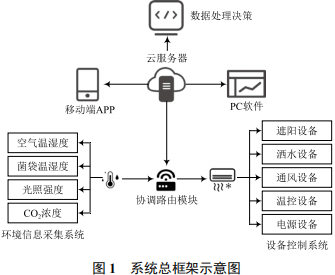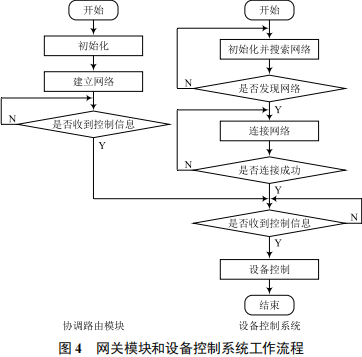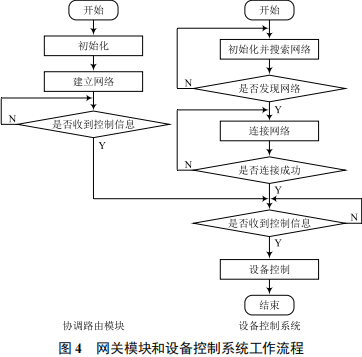Wan Dun, Li Ya, Zhang Yu, Li Zhan, Zhang Xu
(Henan Polytechnic University, Jiaozuo, Henan 454003)
Abstract: The mushroom greenhouse needs to provide a suitable growing environment for mushrooms, in response to the problems existing in the current traditional greenhouse production model, we designed an IoT-based mushroom greenhouse monitoring and control system, to improve yield, and reduce the consumption of human and material resources.This system utilizes the ZigBee network. Multiple environmental monitoring terminal nodes are placed at various locations within a single greenhouse, along with multiple device control terminal nodes and one gateway device; the gateway device collects environmental parameter data from the monitoring terminal nodes in real-time via the ZigBee network, and uploads the collected data to the cloud server in real-time using the MQTT protocol, after which control information from the server is sent to the device control terminal nodes.The system intelligently decides and adjusts the greenhouse environment based on the set optimal growth environmental parameters, and provides users with a designed APP and web interface, as well as abnormal information push and device control services, achieving visual automatic management of the greenhouse.
Keywords: Mushroom greenhouse cultivation ; Environmental factors ; MQTT ; Visualization ; Intelligent control ; ZigBee
Classification Number: TP399 Document Identifier Code: A
Article Number: 2095-1302(2022)08-0007-03
The mushroom industry is a rural economic development project that integrates economic benefits, ecological benefits, and social benefits, developing the mushroom industry meets the needs of growing consumer demand and sustainable agricultural development, and is an effective way for farmers to become wealthy quickly. Although China has gradually become one of the important production areas for mushrooms, there is still a certain gap compared to the quality and yield of mushrooms abroad, mainly because the requirements for different environmental factors during the growth of mushrooms are very stringent. Therefore, researching the theories and methods for regulating the environmental factors in mushroom greenhouses that affect their growth, is a key research direction to improve the quality and yield of mushrooms.
In response to the development of mushrooms, this article utilizes IoT technology and data analysis technology, to design a smart mushroom greenhouse monitoring and control system, to achieve automatic control of the mushroom growth environment and equipment management, increase the yield of mushroom greenhouse cultivation, reduce the consumption of human and material resources, and increase production efficiency.
The environmental characteristics of the mushroom greenhouse are as follows:
(1) During specific growth stages, the environmental parameters are relatively stable;
(2) During specific growth periods, there is no light or only a small amount of light indoors;
(3) Equipped with devices that can ventilate, insulate, and maintain humidity, there are many environmental control devices (lights, fans, humidifiers, curtains, shading systems, etc.).
In response to the above characteristics, to realize the mushroom greenhouse monitoring and control system, the following conditions need to be met:
(1) There must be monitoring modules capable of measuring environmental parameters such as light intensity, temperature, humidity, CO2, etc.; and control modules capable of controlling devices such as lights, fans, humidifiers, curtains, shading systems, etc..
(2) The system must be able to send environmental data to a network server, process and store the data, and based on the data characteristics, make corresponding control of the greenhouse equipment, to achieve automatic adjustment of the mushroom greenhouse environment, maintaining the most suitable environment for mushroom growth.
(3) The system must be able to analyze environmental parameters from the greenhouse, and perform fuzzy data processing based on the growth habits and environmental characteristics of different types of mushrooms, to achieve stable control of the environment.
1.2 System Structure Design
Figure 1 shows the overall design block diagram of the system. To reduce wiring costs, and improve system reliability, the system design adopts ZigBee wireless communication technology and star network topology. From Figure 1, the functions of this system are mainly divided into five parts:
(1) Collection and uploading module for environmental parameter information;
(2) Greenhouse equipment control system;
(3) Information gateway module responsible for information interaction between the environmental parameter information collection system, the device control system, and the server;
(4) Cloud server for environmental parameter information;
(5) Mobile and PC terminal for visual display and remote control of greenhouse data.
The environmental information collection system can realize the collection of air temperature and humidity, light intensity, CO2 concentration, and other parameters, as well as wireless transmission of information.
The gateway module is responsible for gathering environmental parameter information sent by the environmental information collection system via the ZigBee network, packaging the information and sending it to the server, and receiving device control information from the server.




2.2 Software Design Scheme
The server side saves data from the environment, and based on real-time data, calculates the optimal device control scheme through the decision model, and designs a visual software control system for the web and mobile APP.
2.2.1 Data Storage Decision Model


The identity verification module is used to verify user identity, ensuring the legality of access to personal data and information.
The real-time data module displays the data collected by multi-node sensors within the mushroom greenhouse.
The data statistics module displays the collected environmental parameters (temperature, humidity, CO2 concentration, light intensity) in a visual curve format, making it easier for users to observe the environment within the mushroom greenhouse, and make corresponding improvements after analysis, to improve the efficiency of mushroom production.
The device control module displays the current status of environmental control devices within the mushroom greenhouse, allowing the selection of control modes for the devices (intelligent control or manual control). When using intelligent control mode, the system dynamically adjusts control based on the control scheme provided by the data fuzzy processing model, achieving automated control. In manual mode, users can issue corresponding control commands via the software based on their actual needs, and the device control system will execute the corresponding control operations on the greenhouse control devices.
Information push needs to be based on the environmental data of the greenhouse. Based on the analysis of the optimal cultivation conditions and suitable growth range for mushrooms, utilizing the environmental parameter information from the greenhouse along with daily weather and seasonal conditions, different planting guidance is pushed to the greenhouse, making it convenient for users to understand the greenhouse situation, and adjust the greenhouse according to their needs, achieving intelligent control of the optimal growth environment for mushrooms.
In the laboratory simulation of the mushroom greenhouse system, each mushroom greenhouse is equipped with, 5 to 6 sensor nodes, 1 gateway node, 1 PC computer, and a mobile phone that can install the APP.
After successful networking of the hardware nodes and gateway device in the system test, the environmental collection module can collect and send data such as air humidity and temperature, bag temperature and humidity, light intensity, and CO2 concentration to the gateway node, and the gateway node can connect to the network, upload data and issue commands. The network management platform and mobile APP display data in real-time, and through click control, commands can be quickly issued, controlling devices accurately, and making corresponding actions in real-time. Experiments show, that this system has low power consumption, good stability, and can meet the monitoring needs of mushroom growth.
4 Conclusion
References
[1] Yuan Jianfeng, Zheng Hao. Research on Key Technologies of Mushroom Growth Monitoring System Based on IoT [J]. Software, 2020, 41(8): 31-33.
[2] Dou Yifan, Zhong Yunjia, Wang Zhanbei. Design of a Mushroom Greenhouse Environmental Parameter Monitoring and Control System [J]. Electronic Production, 2019, 26(7): 23-26.
[3] Han Yixin. Design and Implementation of Smart Agriculture System for Mushrooms Based on IoT [D]. Shijiazhuang: Hebei University of Science and Technology, 2019.
[4] Zhao Xinhai, Zhang Yingliang, Li Ying, et al. Design of an Intelligent Monitoring and Control System for Mushroom Facility Cultivation Based on Android [J]. Journal of Tianjin Agricultural University, 2018, 25(3): 84-86.
[5] Zhang Rui. Design of a Human Health Monitoring System Based on ZigBee [D]. Qufu: Qufu Normal University, 2014.
[6] Song Weidong, Wang Mingyou, Xiao Hongru, et al. Intelligent Monitoring and Control System for Mushroom Production Based on IoT Technology [J]. China Agricultural Machinery, 2012, 56(4): 142-144.
[7] Long Zulian. Research and Design of Smart Agriculture Control System Based on ZigBee [J]. IoT Technology, 2021, 11(5): 106-108.
[8] Liu Feifei, Xu Longji, Ma Liran. Design of a Distributed Agricultural Environmental Monitoring System Based on ZigBee [J]. Sensors and Microsystems, 2021, 40(3): 90-92.
[9] Zhao Rongyang, Wang Bin, Jiang Chongran, et al. Design of Agricultural Greenhouse Production Environment Monitoring System Based on IoT [J]. Agricultural Machinery Research, 2021, 43(11): 131-137.
[10] Zhang Ping, Hu Yingkun. Intelligent Agricultural Temperature Control System Based on ZigBee and OneNET Cloud Platform [J]. IoT Technology, 2021, 11(1): 25-28.